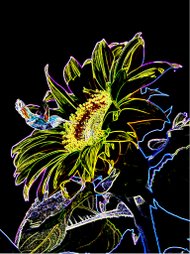This article will cover the basics of hobby aquaponics, and more importantly give step by step instructions on how to build and maintain a small flood and drain aquaponics system.
What is Aquaponics?
Aquaponics is the combination of recalculating aquaculture (fish farming) and hydroponics (growing plants without soil). The fish waste provides the nutrients the plants need and the plants, in taking up these nutrients, help to purify the water in which the fish live. This is an organic process with the only input to the system being fish food which creates a sustainable ecosystem where both plants and fish can thrive.
What Plants Can Grow In This System?
Aquaponics is particularly successful for growing leafy crops like lettuce, herbs, chives, spinach, arugula etc. because of the high nitrogen content in the water, but other food crops do well including tomatoes, cucumbers, peppers, beans, peas, squash and melons, but these fruiting plants may not produce as high a yield as with hydroponics only systems where higher levels of phosphorous and potassium may be maintained.
What about the Fish?
Tilapia are generally the fish of choice for larger aquaponic systems because they are fast growing, can tolerate a wide variety of water quality conditions and have firm white meat. For small hobby systems koi or gold fish work well. It is a good idea to also include a plecostomus cat to help keep the tank clean. Start with approximately one inch of fish for each gallon of water in the tank.
Materials for the System
Tank – Virtually any clean container that can hold ten or more gallons of water will work, but for esthetics and function, fish aquariums work best for most small systems. Fortunately these are readily available used by looking in the Bird and Fish classified adds section of any major newspaper.
Under Gravel Filter and Pump(s) – These can be built, but it is easier to buy them and generally they come with used tanks. The filter needs a means of pulling water through the gravel to promote bio-filtration. This can either be done with an air pump and air stones, or with devices known as “Power Heads” that have an active water pump that draws water up the riser tubes of the filter. The best setup is to have the power heads for the filter and then supplement the dissolved oxygen in the tank with an air pump and air stones. Air hose tubing will be needed as well as a two way gang valve.
Grow Bed – The grow bed can be any container that can sit on top of the tank and that can have holes easily drilled in the bottom. Dish pans, or plastic storage bins work well for this and can be found at discount stores like Wal-Mart or even Dollar stores. The objective is to find something 5-7 inches deep that covers most of the tank surface, but is wide enough to sit on top. Leave a small space for feeding the fish. For ease in maintenance, two or three smaller containers may be placed side by side on top of the tank.
Submersible Pump A pump is needed for flooding the grow bed. For small systems up to two square feed of growing surface a small 160GPH submersible hydroponics pump should be sufficient.
Tubing – Sufficient tubing is needed to go from the pump at the bottom of the tank to the grow bead and to cross the length of the grow bead twice.
Aquarium Gravel – Don’t skimp on this one. By buying aquarium gravel rather than using some other type of gravel you will be sure that it will not leach into your water and impact the PH. Buy enough to cover the under gravel filter with two inches of gravel.
Growing Medium – For this system expanded clay pebbles work well. These are sold under several brand names and can be purchased from any retail hydroponics dealer. Enough will be needed to fill the grow beads to within one inch of the top.
pH Test Kit – This system is very easy to maintain, but starting with proper pH and maintaining it is the key to success. pH test kits are available for as low as five dollars and can be purchased at hardware and pool stores.
Siphon Cleaner – This inexpensive tool is available at all stores that sell aquariums and is indispensable for monthly tank maintenance.
Hydroponics Nutrient (Optional) – The nice thing about an aquaponics system is that the system will produce ample nitrogen needed for green leafy plants to thrive. It is not necessary, but to help maintain better phosphorous, potassium and micro-nutrient levels it is recommended that replacement water be supplemented by adding ¼ the recommended amount of a good hydroponics Bloom formula to the water.
Light Source – If the tank is placed near a sunny window external light may not be needed, but lights often come with used or new tanks and the can be used by changing the bulb to one appropriate for plants. This may not be adequate if the system is relying entirely on artificial light. 20-50 watts per square foot is a good rule of thumb for grow lights if used exclusively. A small stand can easily be made of PCV pipe to hang the light fixture from.
Setting up the System!
Tank Setup - The tank will be set up just like any aquarium. Place the under-gravel filter in the tank with the riser tubes installed, add gravel and then water. Connect air stones to tubing from the air pump and insert them in to the riser tubes from the filter or insert and plug in Power Heads. Once water has been added to the tank the pH will need to be checked and adjusted as needed. If the system was just for raising fish it would be best to try to maintain the water at a pH of about 7.4. In combining fish culture with growing plants (aquaponics), the needs of both the plants and fish must be slightly compromised by maintaining a pH as of about 6.8. More often than not the pH of tap water needs to be lowered. Products for raising and lowering pH that are safe for both plants and fish are available at both hydroponics and fish stores. If fish are to be added immediately the water must be de-chlorinated, otherwise wait 48 hours before adding the fish. To start your system, add approximately one inch of fish for each gallon of water.
Grow Bed Setup –
The grow bed will need one hole in the bottom large enough to feed the pump tubing up through and 3/16th inch drain holes every two inches. As the grow bed will be slightly larger than the tank make sure not to have drain holes near the edges. Most submersible hydroponics pumps come with suction cups that can be used to install the pump on the side of the tank near the bottom. If the pump does not have them it will be necessary to lay a flat slate, or rock on the bottom to set the pump on so it will not clog with gravel. Use a small drill bit to drill holes in both sides of the feed tube in all but the section that will go from the pump up to the grow bed. Feed the tube up through the hole in the grow bed and loop the rest of the line down one side and back up the other of the grow bed. Fold the tube over twice and secure with a zip tie or strong rubber band to block the end of the tube and force the flow out the holes in either side of the tube. If more than one grow bed is used, cut a small notch or hole in the top of the beds for the tube to fit through. Fill the bed with expanded clay medium, or other suitable growing medium, to within one inch from the top and place the feed hose on top. If necessary, to avoid splashing it is helpful to place a small amount of medium on top of the feed hose.
Adding Fish and Plants – It is best to let the system become established for one month with the fish before adding plants. Plants may be started from seeds directly in the grow beds or they may be started in peat and transplanted to the grow beds.
Maintenance
The good news is that this system is very easy to maintain. Each week, check the pH. If the pH is between 6.6 and 7.0 things are going well. If the pH is outside of this range it should be adjusted by using either pH Up or Down as needed. A pH of 6.8 is ideal. Fill the tank to top off the level with de-chlorinated water that has been supplemented to make a ¼ strength hydroponics bloom solution. Each month, use a siphon cleaner to vacuum the excess waste out of the gravel. Take the tank water level down ¼ with this process. Don’t throw this water down the drain; it will do wonders for indoor and outdoor plants. Fill the tank back up to the top with de-chlorinated ¼ strength hydroponics bloom formula.
This small system can not only be an attractive conversation piece, but it can provide enough salad greens and herbs for the whole family.
Dr. Christopher J. Kline is a master gardener and writer living in Paradise Valley Arizona. Chris can be reached at CKline72@Cox.net
Subscribe to:
Post Comments (Atom)



No comments:
Post a Comment